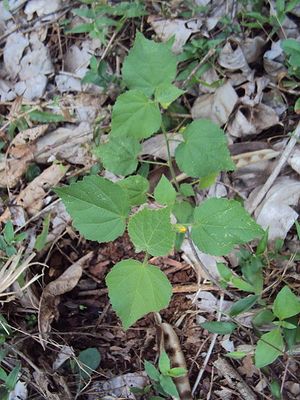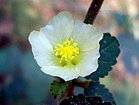Note: This is a project under development. The articles on this wiki are just being initiated and broadly incomplete. You can Help creating new pages.
Sida cordifolia - Bala
Sida cordifolia is a perennial shrub of the mallow family Malvaceae and it is native to India. its seeds and root are used to make medicine.
Uses
Bleeding piles, Diarrhea, Fever, Gonorrhea, Aphrodisiac, wounds, Ophthalmia, Painful urination, Paralysis, headache, loss of voice[1]
Parts Used
Chemical Composition
The following alkaloids were reported from S. cordifolia growing in India and β-phenethylamine, ephedrine, pseudo-ephedrine, S-(+)-Nb-methyltryptophan methyl ester, hypaphorine, vasicinone, vasicinol, choline, and betaine.
Common names
| Language | Common name |
|---|---|
| Kannada | Hethutti, Bili kurunthotti |
| Hindi | Bariar, Kungyi Khareti, Kharenti |
| Malayalam | Vellooram, Velluram |
| Tamil | Mayir-manikham |
| Telugu | Chirubenda |
| Marathi | NA |
| Gujarathi | NA |
| Punjabi | NA |
| Kashmiri | NA |
| Sanskrit | Bala, Batyalaka |
| English | Country mallow |
Properties
Reference: Dravya - Substance, Rasa - Taste, Guna - Qualities, Veerya - Potency, Vipaka - Post-digesion effect, Karma - Pharmacological activity, Prabhava - Therepeutics.
Dravya
Rasa
Guna
Veerya
Vipaka
Karma
Prabhava
Habit
Identification
Leaf
| Kind | Shape | Feature |
|---|---|---|
| serrate | Heart shaped | The leaves are truncate, 2.5-7 cm long and 2.5-5 cm broad, with 7-9 veins |
.[2]
Flower
| Type | Size | Color and composition | Stamen | More information |
|---|---|---|---|---|
| Small | 2.5 cm long | yellow or white in colour | Petals 5 | solitary and axillaries; Calyx campanulate; lobes 5, triangular, densely pubescent outside. Petals 5, pale yellow. Stamens monadelphous and Plant flowers from August to December |
Fruit
| Type | Size | Mass | Appearance | Seeds | More information |
|---|---|---|---|---|---|
| Loculicidal capsule | 7.5–11 cm long, 1.5 cm broad | fruits are with 8 – 10 strongly reticulated mericarps, ciliate on the upper margins and fruiting from October to January. | 12-20 seeds | {{{5}}} | {{{6}}} |
Other features
List of Ayurvedic medicine in which the herb is used
Where to get the saplings
Mode of Propagation
How to plant/cultivate
Prefers a lighter, sandy soil in a sunny position[4]
Commonly seen growing in areas
Photo Gallery
References
- ↑ " Medicinal Use and Health Benefits"
- ↑ "Morphology"
- ↑ Cite error: Invalid
<ref>tag; no text was provided for refs namedAyurvedic preparations - ↑ "Cultivation Details"
External Links
- Pages with reference errors
- Ayurvedic Herbs known to be helpful to treat Bleeding piles
- Ayurvedic Herbs known to be helpful to treat Diarrhea
- Ayurvedic Herbs known to be helpful to treat Fever
- Ayurvedic Herbs known to be helpful to treat Gonorrhea
- Ayurvedic Herbs known to be helpful to treat Aphrodisiac
- Ayurvedic Herbs known to be helpful to treat wounds
- Ayurvedic Herbs known to be helpful to treat Ophthalmia
- Ayurvedic Herbs known to be helpful to treat Painful urination
- Ayurvedic Herbs known to be helpful to treat Paralysis
- Ayurvedic Herbs known to be helpful to treat headache
- Ayurvedic Herbs known to be helpful to treat loss of voice
- Herbs with Roots used in medicine
- Herbs with seed used in medicine
- Herbs with Leaves used in medicine
- Herbs with common name in Kannada
- Herbs with common name in Hindi
- Herbs with common name in Malayalam
- Herbs with common name in Tamil
- Herbs with common name in Telugu
- Herbs with common name in Sanskrit
- Herbs with common name in English
- Habit - perennial shrub
- Index of Plants which can be propagated by Seeds
- Herbs that are commonly seen in the region of Tropical area
- Herbs that are commonly seen in the region of Subtropical area
- Herbs that are commonly seen in the region of Sandy soil area
- Herbs
- Ayurvedic herbs that don't have seed photos
- Malvaceae





